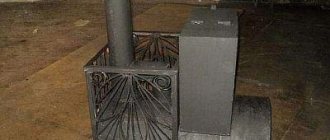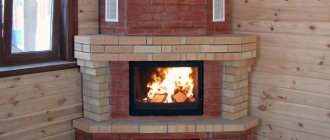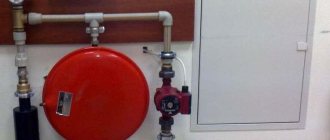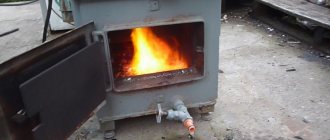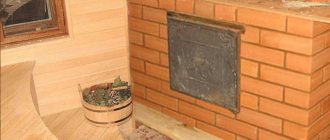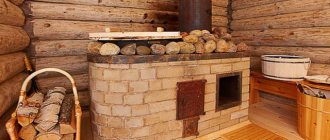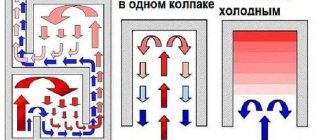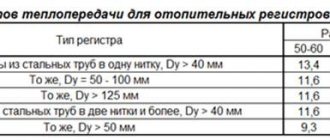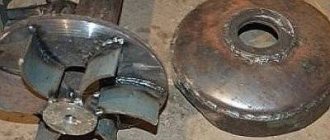The most important stage in the construction of a bathhouse is the installation of a heating device - a stove or boiler. And to figure out how to install a sauna boiler with your own hands, you need to figure out how it differs from a stove.
How to make a cauldron for a bath
Let’s say right away that often there is no particular difference between them. Of course, if the stove was laid out in accordance with all the standards of stove art, then it is impossible to call it a boiler. Just as it is impossible to call an iron barrel used for heating a stove. But their functions are the same:
- heat the room;
- heat water;
- heat the stones.
Types of boilers for baths
According to the type of fuel used, sauna boilers are divided into the following groups:
- solid fuel devices operating on wood, coal, peat, etc.;
Solid fuel unit combined with a stove-stove - electrical;
Electric boiler with hot water tank - gas;
Gas units for baths - boilers that run on liquid fuel - diesel fuel, kerosene, waste oil.
Diesel sauna boiler
When choosing a material there are also some nuances. Thus, cast iron boilers are rarely used, since they cannot be placed in a steam room, but only in a separate room. In the steam room itself you can put:
- iron cauldron;
Diagram of a boiler with a water tank - brick;
- iron, but lined with brick.
Bath cauldron made of metal, lined with brick
For hundreds of years, it was customary to build massive brick stoves in bathhouses, but thanks to modern technologies, today mostly compact metal models are made.
Note! Not everyone can afford to buy a factory-made unit, but if you have certain construction skills, you can make a boiler for a sauna with your own hands.
Prices for the range of solid fuel boilers
Solid fuel boilers
Suitable pipe sizes
Steel pipe as the main raw material for the furnace has a number of advantages. Among them:
- resistance to damage;
- good level of heat transfer;
- rapid heating of the room;
- minimal expansion when heated;
- use of any type of fuel;
- minimum number of welds.
The disadvantages of a metal stove are the same rapid cooling of the room as heating, uneven distribution of heat in the room. To eliminate them, the stove is often lined with bricks.
530 mm
For a steam room of standard sizes, a pipe measuring 530 millimeters is good. A stove made from it will be quite powerful; the wood will burn for a long time, providing good performance. Available in horizontal and vertical versions.
640 mm
A good material option for a large steam room in a bath complex. The large firebox allows you to place a lot of firewood at once, increasing the break between loads to 8 hours.
426 mm
This diameter is enough for a small steam room in a seasonal building, where bathing procedures are combined with washing or dousing with cold water in one room.
It is important to note that cast pipes without seams are an excellent option for small furnace parts; their diameter does not exceed 250 mm. To make the main part of the furnace, it is better to take pieces of spiral pipes - they are reliable and will cost the same as scrap metal. If you can’t find these, you should take straight-seam ones.
What do you need to know?
First you need to decide on the fuel that will be used and, therefore, on the type of boiler. It is not advisable to make electric and gas appliances yourself, but if the choice was made in favor of one of them, then it is better to buy a ready-made high-quality boiler. Otherwise, the risk of emergency situations will increase.
Solid fuel boiler for baths, diagram
It is also worth noting that an installed gas boiler must be inspected by a representative of the relevant authorities. Therefore, it is much easier to assemble and install a solid fuel unit.
Pyrolysis
The operating principle of such boilers is the presence of fuel combustion chambers. The primary combustion process with the release of gas occurs in the first chamber, and in the second - afterburning, direct gas synthesis. To light such a boiler, it is enough to use an electric ignition system. The main advantage of gas pyrolysis boilers is that the fuel burns almost completely, and almost no soot and ash remain.
Design of a pyrolysis boiler.
Among the disadvantages of this type of boiler is the high price. In addition, most pyrolysis boilers for saunas operate only on well-dried wood, for example, boilers from the Czech company Atmos and the Polish Orlan.
Making a boiler for a bath
Making a boiler for a bath
The iron boiler has a fairly simple design. Preparatory work consists of studying boiler drawings, as well as purchasing all the necessary equipment.
Making a boiler for a bath
Stage 1. Consumables and equipment
In most cases, boilers are made of thick-walled metal pipes. Experienced specialists use large barrels with a volume of up to 200 liters, but in our case it is recommended to use a small pipe ø50 cm with a length of 75-100 cm. This will make it possible to design a device capable of heating a room with a volume of 15 cubic meters, which approximately corresponds to an area of 9 m².
Steel pipe for boiler making
In addition, you will need the following tools:
- welding machine (electric);
- Bulgarian;
- metal circles.
Stage 2. Welding of structural supports
Boiler drawing
Cutting the pipe
After preparing everything you need, you can start working.
Step 1. The boiler body will consist of a pipe in which three supports must be formed, located parallel to the ground, at three different levels. To do this, you will need three pieces of reinforcement ø1.4 cm, 3 cm long each.
Level No. 1 is required to install the stove.
The height of level No. 2 is calculated depending on the planned type of blower door.
Level No. 3 should be located 20 cm from the top edge of the structure.
Step 2. A circle of the appropriate diameter, cut from sheet steel 5 mm thick, is used as the bottom.
Furnace from the inside
Step 3. All wood-burning stoves include a grate - a metal grate necessary for supplying oxygen to the combustion chamber (installed from below). It will require a circle of metal of the maximum possible thickness, perforated or with slots.
Furnace design Furnace design
Furnace design
Step 4. The oven lid will also serve as a support for the stones, so it is cut out of the same 5 mm steel. A hole is made in the center of the lid for the chimney pipe.
Step 5. A hole is made in the lower part of the pipe for the box, and it is closed with a stove door.
Note! The depth of the box depends solely on the thickness of the walls!
Step 6. The box itself is constructed, and a partition is installed inside it to separate the combustion and ash chambers. The level of this partition must coincide with the level of the grate, and the grate itself must be located inside the boiler.
On the right side there is a round door for storing stones
Boiler for a bath
Prices for popular models of welding machines
Welders
Stage 3. Assembling the structure
This process can be divided into several stages.
Step 1. First, a box is welded into the structure. If the installation takes place indoors (and in our case this is exactly what happens), then the box should go either into the combustion chamber or outside.
Step 2. Then a chimney pipe is installed on the hole made in the lid.
Ready boiler
Step 3. The foundation for the furnace is built. This can be either an ordinary reinforced concrete slab or a 10-centimeter concrete screed poured onto a “cushion” of crushed stone 15 cm thick.
Step 4. The structure is installed on the base, stones are placed on the lid.
Video - Sauna stove made from a pipe. Design. Manufacturing step by step
Stage 4. Heat shield
Sauna stove with a brick screen
In most cases, the screen is made of brick. This can be done in two ways:
- cover the entire boiler;
- fence it off with a small wall.
Note! Small holes need to be made at the bottom of the screen - they are necessary for air convection.
How to install a metal sauna stove
Design planning
Wood boilers
Start by planning the boiler. The best option is a two-chamber unit that can simultaneously heat the room being served and heat water for the owner’s needs. Firewood is placed in one chamber of such a boiler, and water is heated in the other. The water chamber is usually placed on top. Heating of the liquid in most cases is provided by the heat of the chimney passing through the tank.
A more advanced and cost-effective option for a wood-burning boiler is a unit that operates using the principles of pyrolysis fuel combustion. An artificial air deficit is created in such a boiler. As a result, the fuel does not burn, but slowly smolders with the release of pyrolysis gases. The latter provide additional heating and contribute to a significant increase in the efficiency of the heating unit.
Before starting assembly, perform a series of simple calculations regarding the optimal dimensions and power of the boiler, the size of the heat exchanger, the volume of the tank for heating water and other significant parameters.
Wood boilers
In general, the assembly of most existing varieties of wood-burning heating units is carried out in the same sequence. To increase the efficiency of the boiler, you can change its main characteristics at your discretion. For example, increasing the volume of the heat exchanger jacket will slightly increase the thermal efficiency of the equipment.
Pyrolysis boilers
Choose the best design option, draw up (order, find) drawings and get to work. Start by preparing all the necessary equipment.
Oven made of metal sheets
Stove made of metal sheets
Let's consider another option for a stove for a bath - an open metal heater lined with brick.
Stage 1. Preparing everything you need
Most of the consumables can be purchased at a hardware store, but the components of the firebox are sold only in specialized retail outlets. So, the work requires:
- sheet steel (5 mm) for the walls of the structure;
- steel (10 mm) for the bottom - it should be thicker, since the lower part of the boiler is usually more exposed to high temperatures;
- factory boiler elements (doors, taps, tank, etc.);
- reinforcement rods ø3 mm - a mesh for stones will be constructed from them;
- channels;
- 1.5 mm thick tin for making a chimney (more precisely, its lower part);
- asbestos for the top of the pipe.
Note! To fasten the chimney elements, a flange connection is used, and a damper is installed at the junction. This is the most fireproof option, since most of the channel will be protected from ultra-high temperatures.
Stage 2. Assembling the structure
Heater stoves with a built-in water tank: a - heater with single walls;
b - heater with a side wall in the form of a water tank; c - heater with water tanks and an air gap in the wall Step 1. First, a drawing of the future boiler is created - this is a very important and mandatory stage of work. The drawing should include: a top, side and sectional view of the structure, the main parameters of all elements separately (in millimeters), sketches of the most important components, etc.
To do this, you need to clearly understand the principle of operation of the boiler, master special terms and the “language” of the circuit.
Marking a metal sheet
Welding a body from steel sheets cut according to markings
Housing welding
Housing welding
Step 2. Buying everything you need (this was described in the previous section).
Step 3. Metal cutting is performed. A thick-walled box is formed from sheet steel, which will serve as the body for the boiler.
Note! When cutting, you should use only high-quality metal scissors, since the evenness of the edges will depend on this.
Step 4. The cut sheets are welded. To do this, you need to be a professional welder or hire one (for an appropriate fee), because the welding seams must be perfect.
We weld a piece of pipe inside the furnace body Weld a piece of pipe inside the furnace body
We form a water tank. We cut a hole in the combustion chamber for the chimney
Water tank and chimney with damper
We equip the stove with a combustion door
We weld a pipe to connect the tap to the back of the water heating boiler
Step 5. A brick screen is built. It is necessary to mitigate the effects of high temperatures, the source of which will be a metal structure. A kind of brick box is constructed with ventilation holes around the perimeter (as in the previous version).
An example of lining a stove in a bathhouse with bricks
An example of lining a stove in a bathhouse with bricks
Device
Before making a solid fuel boiler, it is advisable to design or find an accurate drawing. This will help avoid a lengthy fitting process when producing individual parts. The operating principle of all such devices is approximately the same, which means that the drawings will be similar to each other
It is worth paying attention to the dimensions of the installation, pipe diameters, and the depth of the loading space. The good thing about a homemade boiler is that the parameters can be changed to suit your needs. The heater should not take up too much space, be close to the wall, or have pipe sizes incompatible with the room in which it will be located
The heater should not take up too much space, be close to the wall, or have pipe sizes incompatible with the room in which it will be located.
A long-burning boiler with a vertical firebox (also called “bubafonya”). They are assembled mainly from steel with high heat resistance. The thickness of the metal walls should be 4-6 mm so that the steel does not burn out in the shortest possible time. Very often, an empty gas cylinder or a small barrel is used as a basis. Kindling will be done using wood or pellets. A piston is placed on top of them, which exerts pressure, preventing the formation of an air gap, which accelerates combustion. Otherwise, this device is called an “air distributor”; in the middle of the distributor there is a hole for air to pass into the firebox. The part is a disc-shaped piece of sheet steel, no more than 5 mm thick, and a diameter slightly less than the diameter of the firebox, so that it can be freely moved in the firebox, with a steel rod welded to it. On the firewood side of the distributor there are 50 cm partitions for air passage. This is the optimal size, because when increased, the fuel will burn out very quickly, and when decreased, it will fade
Partitions are installed (it is important that they are in the shape of an arc) so that it looks like an impeller
Construction of a solid fuel boiler
A solid fuel boiler can be connected to the heating system in the house. To do this, you must implement one of the following schemes:
- Run a coil through the firebox through which the liquid will flow and heat up;
- Install the chimney so that it passes through a vessel with liquid; the smoke has a fairly high temperature at the outlet, which means it will effectively heat the liquid.
Summarize
Modern sauna boilers are sold in stores in a wide variety. Unfortunately, among a large number of models you can find too expensive options that are unaffordable. There are also economical options, but they are of poor quality, primarily due to the use of cheap material. As a result, it is the independent manufacture of boilers and their installation with your own hands that are becoming increasingly popular, especially considering that this is a fairly simple job if you prepare for it correctly and use all the useful recommendations.
Kinds
Sauna boilers can be made independently from a barrel or from metal sheets. Each of them will be discussed below.
- Boilers made from barrels. Sauna boilers made from a barrel are compact stoves, the main element of which is a barrel with a volume of at least 200 liters. It should be noted that the barrel must be Soviet-made, since they are much stronger than modern ones. The same barrel is divided into two parts by a special partition. In the lower part there is a firebox, under which there is an ash pit with a palace. The upper part is a water heating tank. There is a hole in the partition that separates the water tank from the firebox through which the chimney passes. At one end it is connected to the firebox, and at the other end it goes outside through the partition and the layer of water in the tank. The heater, where the stones are located, is located on the side as close as possible to the firebox for efficient heating.
- Boilers made of metal sheets. Such furnaces have a similar structure to barrel boilers, but unlike them, they have a quadrangular cross-section. In general, sheet metal furnaces consist of three sections:
- Water heating tank. He is located above everyone else. A chimney pipe passes through this tank, as in the case of barrel stoves.
- Kamenka. It is located below the water heating tank. There are stones here. The walls of this section are lined from the inside with a fire-resistant layer of brick. This layer is called a lining.
- Combustion chamber. It is the lowest section of the structure. There is also a lining here. This section is further divided into two parts. The upper part is the firebox itself, and the lower part is the ash pan. The partition between them is made of a metal lattice.
Boilers for baths can also be classified according to the type of fuel they operate on. So, the following types are distinguished:
- Gas units. Such boilers run on gas, and would be an ideal option if the house has a gas supply system. Such units themselves are very compact and take up little space. In addition, they do not emit any odors or waste. There are three types:
- Single-circuit. Such units are designed to heat a small bathhouse.
- Dual-circuit. They are designed to heat a bath and a small amount of water.
- Three-circuit. They can heat a radiant floor system and also heat a small swimming pool.
- Electrical. If gas is not supplied to the house, then you can purchase electric boilers that operate on electricity. The undoubted advantage of such units is that they can be adjusted to a specific temperature. They are also environmentally friendly, as they do not emit any waste. Despite these advantages, these units still have one main drawback - increased energy consumption. Electricity is currently becoming more expensive, so not everyone can afford such a structure.
- A solid fuel unit is also a good option for baths. But they do not have an automation system, that is, they cannot work in automatic mode. Therefore, you will have to approach each time and load a certain portion of fuel. Modern boilers are manufactured in such a way as to extract as much heat as possible from the fuel. To this end, the thermal insulation of solid fuel boilers continues to be improved to reduce heat loss.
- Units running on diesel fuel. Such boilers are very convenient to use, since they can be refueled once every six months or a year. The most important thing is to find a special container for storing diesel fuel. Some people buy large quantities of fuel and store them underground, refueling the unit once a year. Such a unit requires a separate room, and all work related to the installation and repair of such boilers should be left to an experienced specialist.
- Pyrolysis boilers. Such units mainly run on wood. Unlike conventional stoves, they have two combustion chambers. In the first chamber, the firewood is exposed to high temperatures without air access, where it decomposes, releasing gas. This gas is collected and sent to the second firebox, where it burns. In this way, combustion of fuel without residues is achieved. The main disadvantage is the high price.
https://youtube.com/watch?v=z22zuI04mqo
Where to install heat exchangers
Most often, heat exchangers are installed in the upper part of the firebox.
Scheme of possible installation of a heat exchanger
Installation diagram of a heat exchanger in a vertical furnace
We do not recommend this arrangement for two reasons.
- In the upper part of the furnace, flue gases contain the maximum amount of soot. It is inevitably deposited on the bottom plane of the heat exchangers, the heat transfer efficiency is significantly reduced, and the bottom must be cleaned frequently to improve efficiency.
- The very high temperature of the flame in this place has a negative effect on the metal.
It is much more productive to place the heat exchanger at the edges of the firebox, making them in the shape of the letter P. This will make it possible not only to reduce the amount of soot, but also to increase the total effective area.
Heat exchanger in the furnace
Some practical tips
To avoid unproductive losses of thermal energy, the boiler must be insulated. Wrap it with foil rolled mineral wool, leaving no gaps. The thickness of the wool should be at least 10 cm.
To calculate boiler power there is no need to use complex formulas. Practice shows that to heat one square meter of room in the southern regions, 100÷120 W is enough, in the northern regions approximately 150÷200 W are needed. Based on these data, select the power of the heating elements.
Circulation pumps are marked on the body indicating the diameter of the connecting thread, maximum lift height, power, permissible installation length of pipelines and channels of heating batteries
Approach the choice of a specific brand of pump carefully, pay attention to all its indicators and technical characteristics. Buy pumps with a reserve, do not allow them to operate at limit values
The power reserve of approximately 30% doubles the operating time of the equipment.
Circulation pump
If you plan to install a heat exchanger in a solid fuel boiler, then under no circumstances increase the combustion time of the fuel. The heat transfer of fuel per unit time can decrease so much that the heating temperature of the coolant will be insufficient to heat the premises. Anyone can make a boiler and radiator according to their own drawings; it is impossible to determine the optimal combustion parameters in advance; you will have to go by experience. In order to avoid problems during the operation of the sauna boiler, make all heating elements with a power reserve.
Homemade heat exchanger
Heat exchanger made of cast iron radiator
Nuances to consider before installing a gas stove
We have not touched upon the topic of making a gas oven yourself for one simple reason:
IMPORTANT! Homemade gas stoves and gas burners are not certified; they are prohibited from use by law. In case of violation, you will have to pay fines.. The only thing in your power is to buy a ready-made burner and prepare the stove for gasification
Compliance with the following standards should be checked:
The only thing in your power is to buy a ready-made burner and prepare the stove for gasification. Compliance with the following standards should be checked:
- the firebox must (!) go into the dressing room, and the firebox opening is finished with iron;
- dimensions of the firebox opening: 47-55 cm in height, 35-45 cm in width, and if together with a metal frame, then 61-68 and 51-66 cm, respectively;
- The minimum room volume for installing a gas stove is 8 cubic meters. (Remember, yes, that atmospheric ones are installed with a volume of at least 12 cubic meters);
- the height of the room cannot be less than 2.2 m;
- It is necessary to have a window with an area of 0.6 sq. meter, a gap under the door to the steam room from 4 cm or a ventilation grille;
- the refractory material under the stove must be at least 10 cm wider than the dimensions of the stove on each side;
- combustible walls should not be closer than half a meter to the heating device.
IMPORTANT! All work related to gasification is carried out by professionals.
Installation recommendations
Due to the heavy weight of the metal structure, it is not recommended to install the boiler on the floor. For this purpose, you should first build a concrete or brick foundation of the appropriate size and height.
It is also recommended to determine the location of the chimney outlet in advance, so as not to have to deal with the tedious installation of turns later.
In addition, the pipe can burn out quite quickly at the bend. It is better to use special two-layer sandwich pipes. This will help limit direct contact of wooden roofing and ceiling elements with an iron pipe, which can heat up to very high temperatures under the influence of flue gases.
Despite high temperatures, the boiler can be painted. For these purposes, there are special heat-resistant polymer paints, which are freely sold in construction stores.
How to install correctly
Before proceeding with the installation of the boiler, it is necessary to build a strong foundation. It is made of refractory bricks, in several layers. Then the already prepared concrete solution is poured there, after which the structure is installed.
The walls to which the structure adjoins, and some part of the ceiling through which the chimney exits to the outside, should be laid with a layer of fire-resistant material, for example, Izover material. It should also be borne in mind that the chimney pipe must be straight, and without any bends or turns should come out strictly vertically upward.
Usually the pipe has to be bent if the structure was first made, and only after that they began to think about its location. Therefore, you first need to decide on the location of the structure, and only then begin manufacturing the structure.
The boiler is the main attribute of the bathhouse. For it to truly perform its functions, it must be installed correctly, in accordance with all the rules. Only then will the operating process be a pleasure
